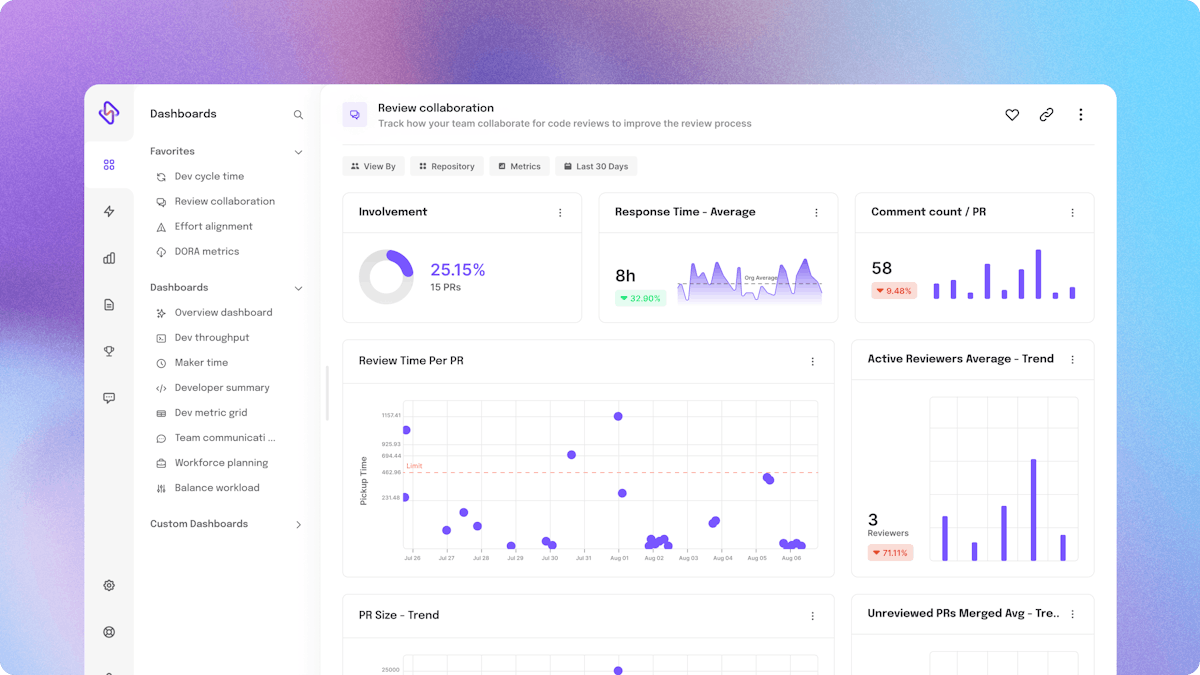It’s no secret that engineers love to code, and sharpen their problem solving skills. They love the thrill of building omnipresent applications, chauffeuring their creative side, and making the world a better, and tech-enabled place with all the innovative stuff they build. They form a special bond with their VCS, the tools used, processes involved, and most importantly, their workflows that help them code better and faster, with time to groom, and innovate.
But here's the catch. Like any other relationship, this fusion is driven by a lot of pain-points as much as it is fun. Engineers can only do their best work, when they have a supportive workflow.
Workflows are meant to help devs work better, smarter, and faster while keeping up with the dynamic nature of the tech industry. However, it is too perfect to be true. Today, 92% of teams are dealing with inefficient developer workflows, leading to loss of productivity, delayed software delivery, average product quality, and even developer burnout.
So, our guide explains what developer workflow is, effects of inefficient developer workflows and how to improve it to maximize developer productivity.
What Is The Developer Workflow?
The developer workflow involves processes, tools, or methodologies a developer uses right from creating their first codebase to final deployment, testing, and dispatching it to customers.
It's the series of steps a developer takes to turn their ideas into functioning software. Team size, project type, and even a developer’s personal style of doing things have a lot of say in how modern day workflows turn out.
Different developer workflows together constitute the development cycle, with the former impacting the efficiency of the whole SDLC. A typical developer workflow includes:
- Planning for your project: How to get started, outlining project requirements, the timelines involved, and identifying milestones
- Coding involves writing and testing code, with best practices in place to ensure code quality and consistency and achieve industry standards
- Testing to track down any pesky bugs hindering your software's performance. Error-free products go a long way in building customer experience- something all PLG teams are striving for today.
- Deployment involves monitoring, troubleshooting, maintenance, and releasing the software to production.
Now that we have seen an overview of a typical developer workflow, let’s see how it impacts engineering productivity.
Reasons for Inefficient Developer Workflows
Inefficient developer workflows can be attributed to various factors that hinder productivity and delay the smooth execution of projects.
Let's explore some common reasons behind such inefficiencies:
1. Use of outdated tools and technology:
Outdated tools and technology can significantly impact developer workflows. Legacy systems, obsolete software, and inefficient tools can slow down development processes, hinder productivity, and limit the adoption of modern practices. Upgrading to newer tools and technologies that facilitate automation, streamline tasks, and support efficient collaboration can help overcome these workflow inefficiencies.
2. Inadequate training and organization:
Insufficient training and organization within development teams can contribute to inefficiencies. When team members lack the necessary skills and knowledge to handle tasks efficiently, it can lead to delays, errors, and suboptimal outcomes. Moreover, a lack of well-defined processes and project organization can result in confusion, unclear responsibilities, and a lack of clarity in workflows.
3. Overcomplicated processes:
Overcomplicated processes can hinder developer workflows by introducing unnecessary complexity and overhead. Cumbersome approval processes, excessive documentation requirements, and redundant steps can drain time and resources, impeding the progress of projects. Simplifying and streamlining workflows by eliminating non-value-added activities can help alleviate these inefficiencies.
4. Unplanned changes and requirements:
Unplanned changes and requirements can disrupt workflows and cause inefficiencies. Frequent scope changes, last-minute additions, and inadequate project planning can lead to shifting priorities, rework, and delays. It's essential to establish effective change management processes, conduct thorough requirements analysis, and maintain clear project objectives to minimize these disruptions and keep workflows on track.
5. Too Many Manual Processes
Lack of automation is the number #1 red flag for any team workflow. 90% of devs are already overwhelmed with repetitive tasks, they have to cast hours aside for work that can be easily automated, or put on auto-pilot. Even after so many hauls and cries around automation, still 40% of workers spend a quarter of their week on manual tasks and lack fully automated builds, and deployment- all leading to a lot of wasted hours for developers.
The Cost Of Inefficient Developer Workflows
Inefficient workflows are a known developer productivity killer. Devs constantly strive to produce higher quality software in minimal time, however, with redundant processes, and friction-filled hand-offs, the idea just seems a distant dream.
[Read more: Navigating the developer productivity Crisis]
Let us understand the effects of inefficient developer workflows and how developers pay the price for slow workflows.
1. Technical debt
Technical debt is the burden devs share to maintain and update old or inefficient code. For 60% of devs, technical debt is a dent on their growth. Technical debt is a common occurrence in teams having a lack of proper code practices in place, and slows down any tech-driven initiative.
Technical debt is both a cause and result of inefficient workflows where engineering teams have to resort to shortcuts to just get work done.
2. Flaky Builds
Take a software team working on some new product feature, and one of the automated tests fails intermittently. The team will spend hours trying to diagnose the issue, leading to delayed project timelines, and frustrated devs. That’s what flaky builds do to software teams- slowing them down, rising team frictions, and causing a dent on developer productivity.
3. Rising Communication Debt
Inefficient workflows cause communication issues between team members, snowballing into reduced cohesion among members, hassled hand-offs, and even delayed software delivery. That’s simply inexcusable for companies who are already struggling with higher developer attrition, and low engineering efficiency in the era of “The Great Resignation”.
Code reviews bear the brunt of communication barriers in a team, even harming the overall code quality. This constant back and forth with no definite results can disempower devs from producing their best work. Today, 45% of developers struggle with the issue as they find it difficult to track their colleagues for hand-offs, and information.
4. No Policies on Standardization
An engineering team has an inconsistent coding process, they do not have documented code review practice in place, and no one knows what their teammates are working on. A reviewer is struggling to understand the context behind a PR sent by the commit owner, so he keeps it on the back burner till it's high time.
Devs might feel lost and overwhelmed if the workplace lacks documentation, or standard processes to get work done. For them searching for proper documentation is more painful than muscle cramps post workout.
3 Tips to Improve Developer Workflows
Here's how developers can bring efficiency into their workflows and improve their productivity:
1. Automating Code Review Process
Companies big or small have to deal with dysfunctional code reviews at some point of time. The ‘pain’ behind these reviews is a symptom that you need to churn out your workflows. Microsoft’s development team too had to deal with the burning issue. However, the team then went on to streamline their workflow through an internal tool called CodeFlow. They automated the whole review cycle, and plugged feedback loops for better handshakes. As a result, the team reduced their review time by 90%, while delivering constant quality.
Use automation, wherever possible, especially in reviews and testing to get work done faster. Automating repetitive tasks also help devs to reserve some free time for their growth and development.
Engineering teams can optimize their code review workflow through pull request templates and automated testing frameworks.
2. Find a balance between writing code and maintaining documentation
Developers often struggle with maintaining, and handing over documentation, and simply see it as a tertiary task. However, documentation is necessary evil to have sustainable workflows. Use automated tools like Swagger or Javadoc to generate documentation as you code. The idea is to free up at least 20-40% of development time via standardization, and scale without hassles as teams move ahead.
The increased traceability can also help teams grow the speed of processing, and consuming documents- all leading to better workflows, and enhanced productivity.
Atlassian recently created "Code Insights" to help developers understand the impact of their code changes on documentation. The results were pretty obvious! 30% increase in code quality and a 25% decrease in the time it takes to update documentation.
3. Embrace agile
Agile sprint has already put enough emphasis on collaboration, flexibility, and rapid iteration. By breaking down development into smaller, manageable chunks, developers can anticipate issues better, work more productively and deliver software frequently.
Spotify used agile methodology to root out any bottleneck in their traditional workflows. By introducing two-week sprints, and a compulsory sprint review coupled with IC-EM 1:1s, the team managed to boost their customer experience by 50%.
Spotify is the best example of how bringing workability into developer flows can go a long way in building product resonance among customers.
Conclusion
In 2021, Garter published a report on how to retain engineering talent, while ensuring they remain productive throughout. The results were staggering, but predictable!
The reports confirmed how investing in pro-developer technologies, and improving their workflows can help in achieving business outcomes. Developer workflows are complex, and bringing chaos into this madness is not a one time deal. It requires consistent efforts, conversations with devs, and regular feedback.
Shopify has a "handoff template" to ensure feedback is taken at the right time, team work in cohesion with each other. The idea is to plug any gap between developers, managers, QA teams, or designers for all purposes, from review to testing, and debugging. Engineering teams can create their very own handoff templates suiting their needs.
Engineering efficiency today is directly related to developer productivity, and coherent workflows. For teams looking to optimize their resources, improve productivity while boosting delivery results- creating functional workflows are the way to start.
An engineering analytics platform can help teams take care of their inefficient workflows with ease. Hatica supports seamless code review collaborations by bringing the commit owner, and reviewer at the same place, with advanced capabilities to track PR changes, and ensuring code reviews aren’t treated as just another secondary work.






